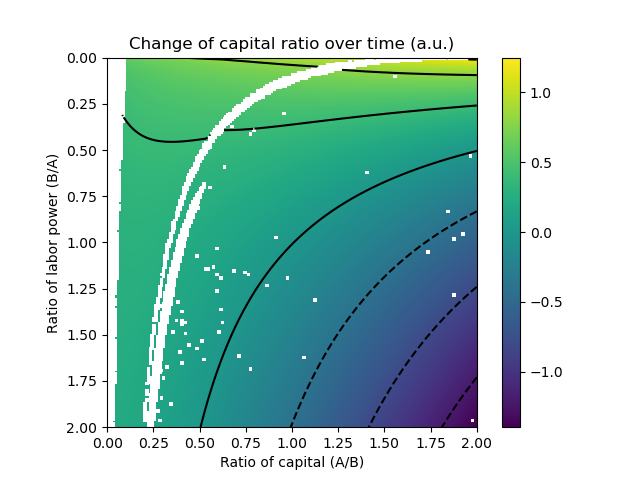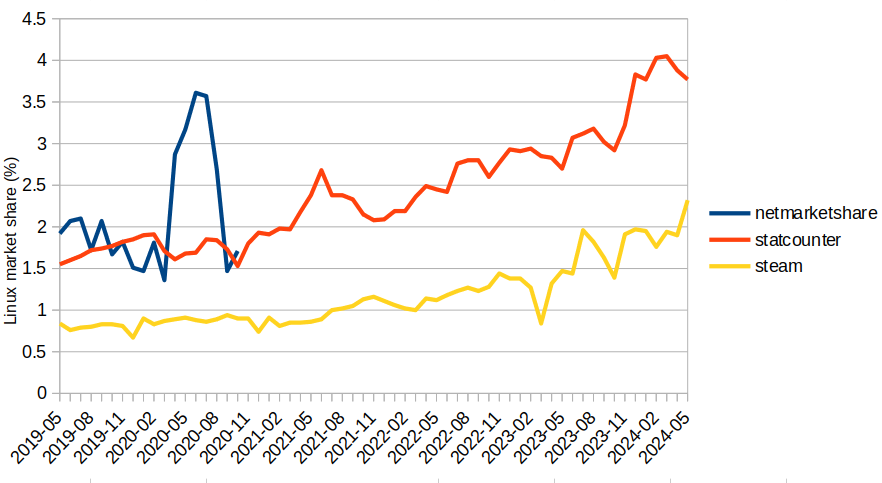This is a sequel to my previous post. The idea is the same, but I'm using better methods as was suggested in the comments.
As u/Sodium_nitride (thank you!) explained, here...
- ...I use a production matrix instead of the Cobb-Douglas function.
- ...I use capital-time instead of capital, to handle depreciation.
- ...classes consume commodities, seeking to maximize the amount consumed.
Also, I purchased the book suggested by u/davel :)
We use the following definitions:
- Labor is measured relative to A's total labor power.
- B has
blabor power, assumed to be proportional to population. - Capital-time and commodities are measured in units of what can be produced directly from 1 unit of labor.
- Labor sold is represented with
w, and the salary is used to purchase capital-times_kand commoditiess_c. - Consumption of A is
c, while that of B isz*b*c, wherezis the ratio of per capita consumption.
Production matrix:
/0 0 0\
A = |1 m 0|
\1 n 0/
Input vectors:
/ 1 - w \
x_A = |k_A + s_k|
\ 0 /
/ b + w \
x_B = |k_B - s_k|
\ 0 /
Demand vectors:
/ w - 1 \
y_A = | -s_k |
\c - s_c/
/ -b - w \
y_B = | s_k |
\z*b*c + s_c/
Payoff functions:
X_A = c
X_B = z*c
Case 1: full equilibrium
In this case, we assume that A and B can negotiate w, s_k and s_c freely,
with no party being able to obtain a better bargaining position.
The Nash equilibrium is:
w = s_k = s_c = 0
c = (m - n - 1)/(m - 1)
z = 1
That is, both groups are independent and produce their own capital-time and commodities. Their consumption is directly proportional to their labor power. Effectively, there is no difference between A and B, any member of either group belongs to the same class.
Case 2: asymmetric capital ownership
Here, we set k_A = s_k = 0, so A owns no capital-time. A and B can negotiate w and s_c
under the same conditions as in Case 1.
The Nash equilibrium is:
w = 1
s_c = c = (1/2)*(m - n - 1)/(m - 1)
z = 2 + 1/b
As can be seen, in this case A works for B and obtains a salary.
Interestingly, this salary is exactly half of what A would have obtained in Case 1. From this and z's non-dependence on
m and n, we can deduce that increases in productivity scale
both A's and B's earnings with the same coefficient, so it's impossible for B to force A's income to any specific minimum.
We also see that B's per capita income is higher when less people belong to the group. For a small enough group, B's total income approaches that of A, just extremely concentrated.
A plausible hypothesis here is that, if the initial situation is Case 2 but productivity is more than high enough to sustain A's needs (thanks to the inevitable scaling described before), then A would be able to eventually negotiate their way to the final equilibrium, Case 1, provided a minimally feasible way to obtain capital.
If that is the case, the (surreal, but theoretically interesting) requirements to get to the equilibrium could be summarized like this:
- All members of A cooperate perfectly (obviously false).
- B has no way to gain an advantage (bourgeois state in general).
- The productive forces have developed beyond a critical point.
Further questions
- How could one verify the hypothesis above? I know how to use production matrices in a state of equilibrium, but what about transient states?
- What if individuals can freely move across groups as their economic status changes and so do their interests? I know nothing about cooperative game theory, so this could be an interesting start.
- What if members of A and/or B do not cooperate perfectly?
- What are the minimum requirements for a mechanism that could allow the cooperative result in a non-cooperative Nash equilibrium?



Western companies outsource much of their production to countries with cheaper labor, so the really important things here are cheap raw materials and state subsidies. Since the Chinese state owns many of the large companies there, they can reduce profits throughout the supply chain or move them to other companies in the form of these subsidies. As well as use that money to build transport and green energy infrastructure, further lowering manufacturing costs.
Investors always seek short-term profit, so playing the long game is something you need aggressive policies for.